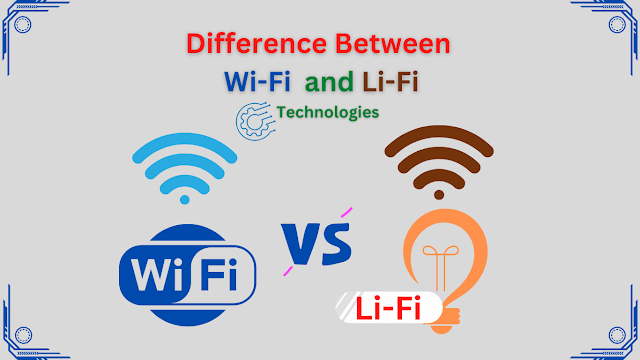Difference Between Li-Fi and Wi-Fi Technology
Wi-Fi and Li-Fi both are wireless method of data transmission, but are different in technology usage. Wi-Fi uses radio waves while Li-Fi uses visible light for data transmission. You are more familiar with Wi-Fi but I am sure very few peoples known about this Li-Fi technology.
So, let’s know about these technologies in brief:
What is Wi-Fi?
Wi-Fi is a wireless networking protocol through which devices use to communicate without direct cable connections. Wi-Fi stands for Wireless Fidelity.
It is based on 802.11 IEEE network standards. The Wi-Fi standards were created by the Institute of Electrical and Electronics Engineers and are certified by the Wi-Fi Alliance. In 1991, NCR Corporation with AT&T Corporation invented the precursor to 802.11 but actually It has started in the Year 1997 with 902.11 standard.
The main requirement for Wi-Fi is a device that receives and transmits a wireless signal, usually a router. Wi-Fi network is established by installing Wi-Fi AP (Access Point) or Wi-Fi router. The Wi-Fi router or AP is connected with the internet using physical or wired Ethernet cable or Fibre optic cable.
Types of Band in Wi-Fi System
It works on two bands one is 2.4 GHz band and second 5GHz. In lower frequency band Wi-Fi coverage is good compare to high frequency band. 2.4 GHz band outshines 5 GHz band in terms of Wi-Fi coverage. The lower frequency band transmitted low frequency signals that more easily penetrate solid objects; it means better signal carried out throughout your home. In case of speed the 2.4 GHz band supports speed up to 600 Mbps while 5 GHz band supports speed up to 1300 Mbps (megabytes per second).
In the 2.4 GHz band, you have the option to choose from 11 Wi-Fi channels, where 3 of which are non-overlapping. In the 5 GHz band, you have the option to choose from 45 Wi-Fi channels, where 24 of which are non-overlapping. Overlapping channels are what lead to network interference, so comparing the two Wi-Fi frequency bands; we can easily see that 5GHz provides less room for co-channel interference.
Watch the below video for knowing quick difference.
Advantages of Wi-Fi
- Convenience: Wi-Fi helps to connect the devices to internet wherever they can locate a Wi-Fi Signal. So it is very convenient to connect to internet using this technology.
- Mobility: It provides mobility means you can use this technology from anywhere anytime.
- Cost Saving : Wi-Fi is easier and cheaper to install in comparison to broadband.
Disadvantages of Wi-Fi
- Data transfer rate decreases (to individual computer) when number of clients or computers connected with Wi-Fi network increases.
- Security : It is more prone to cyber attack. It can be accessed by unauthorised user if you ignore securing your Wi-Fi system.
What is Li-Fi?
LiFi (short for light fidelity) is wireless communication technology which utilizes light to transmit data. Li-Fi uses visible light. It was first introduce by Harlad Hass in the year 2011. He is also known as father of Li-Fi.
This technology only needs a light source with a chip to transmit an internet signal through light waves. This indicates that Li-Fi has a wider range of available frequencies as the visible light spectrum is much larger (10,000 times) than the entire radio spectrum. It covers frequencies from 430,000 to 770,000 GHz and colours from near-ultraviolet to near-infrared. It is based on IEEE 802.15.7 standard protocol. (IEEE 802.15 is the working group for Wireless Specialty Networks (WSN), which are used in IoT, wearables and autonomous vehicles.)
Type of LED used
Micro-sized Gallium Nitride (GaN) light emitting diodes (mirco-LEDs) are excellent options for Li-Fi (Light fidelity) and VLC (visible light communication) because of their large bandwidths.
The technology makes a LED light bulb emit pulses of light that are undetectable to the human eye and within those emitted pulses, data can travel to and from receivers.
The biggest LiFi companies are Signify, PureLiFi, Oledcomm and VLNComm.
Advantages of Li-Fi
- Can be used in Sensitive
to Electromagnetic Area like Hospitals and Airplanes
- Cheap to implement
- Enabling of the Internet-of-Things
- Low cost because of VLC technology used which in turn uses highly efficient LED bulbs.
- Less interference, ability to travel across salt water, and ability to operate in dense areas.
Disadvantages of Li-Fi
- The light source must constantly be on in order to provide network connectivity.
- Light wave has very short range that’s why Users are made stationary when using Li-Fi devices?
- Interference from external source of light like Sun
Key Difference in both the technology:
Wi-Fi Technology:
- Wi-Fi stands for Wireless Fidelity.
- It was invented by NCR Corporation in the Year 1991 but the first version of the 802.11 protocol was released in 1997.
- It is based on IEEE 802.11 standard protocol.
- This technology uses radio waves to transmit data using router.
- Wi-Fi transfer speed ranges from 150 Mbps to 2Gbps.
- It works on two frequencies 2.4 GHz and 5 GHz.
- Its coverage area is upto 32meters
- It is used in internet browsing, Surveillance Camera and smart home
Li-Fi Technology:
- Li-Fi stands for Light Fidelity.
- Its invention credit goes to Professor Harald Haas, who invented it in the Year 2011
- It is based on IEEE 802.15.7 standard protocol. (
- Li-Fi transmits data using light signal using LED bulb.
- Its transfer speed is about 1Gbps.
- It is 10000 times above par radio frequency.
- Its coverage area is about 10 meters
- It can be used in airlines, under sea water and hospitals.
Basically these technologies are used for internet based applications.




Comments